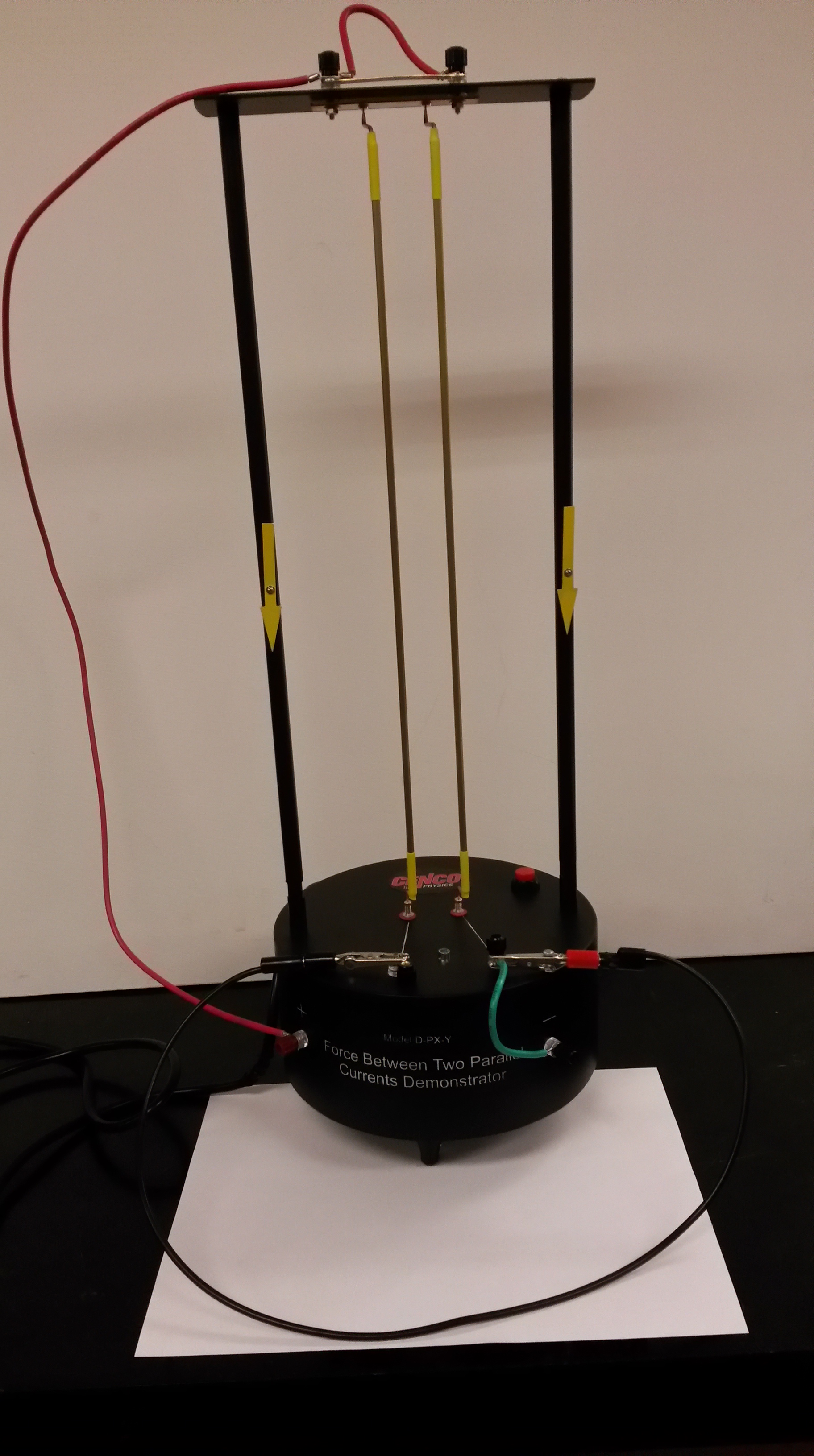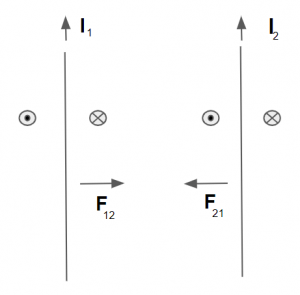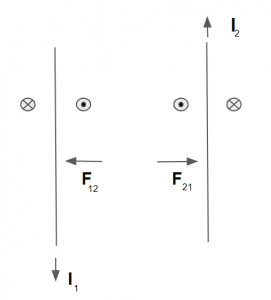
Magnetic field of parallel currents demo
This portable demo shows the force between two current-carrying rods as a result of magnetic repulsion or attraction. The copper rods swing freely, and will be attracted or repelled from each other depending on the currents passing through them.
There are four possible configurations for the current:
- Parallel connection, both currents flowing up (away from the base)
- Parallel connection, both currents flowing down (towards the base)
- Antiparallel connection, currents flow clockwise
- Antiparallel connection, currents flow counter-clockwise
When the two currents are parallel, the rods will attract, and when they are antiparallel, the rods will repel.
Equipment
- Parallel currents setup (shown in picture)
- Extra banana cable with two alligator clips
- Outlet (no power supply necessary)
Procedure
- Connect the wires in the desired configuration (parallel or antiparallel)
- Check that the conducting rods can swing freely and do not tend to swing in one direction or the other (the feet on the base can be adjusted).
- Plug apparatus into outlet
- Keeping hands well away from the conductors/contacts, push and hold the red button on the base. The green light will come on, indicating that currents are flowing. The conductors will move towards or away from each other, depending on the configuration.
- DO NOT HOLD THE BUTTON FOR MORE THAN 5 SECONDS – else everything will get too hot!
- To show a different configuration, unplug the apparatus and adjust wires.
Explanation
This demonstration depicts Ampere’s law and the Lorentz force.
Ampere’s law states that if you add up the magnetic field at each point along a path that encloses a current carrying wire, it will be proportional to the current traveling through the wire by the permeability of free space. Ampere’s law is given by the following equation:
where is the magnetic field,
is an infinitesimal line segment of the current carrying wire,
is the permeability of free space, and
is the current that is traveling through the wire. Applying Ampere’s law to a current carrying wire results in the following equation:
Here, is the radial distance away from the wire, which shows that the magnetic field dies off the further you get from the wire. The direction of the magnetic field may also be determined by the Right Hand Rule. When you use the RHR for a current carrying wire, align your thumb in the direction of the current. The direction in which you curl your hands to make a fist is the same direction of the magnetic field that is produced by the current carrying wire.
When two current carrying wires are brought near each other, each will experience a force from the other wire due to a phenomena known as the Lorentz force. The Lorentz force says that a moving charge in an externally applied magnetic field will experience a force, because current consists of many charged particles (electrons) moving through a wire, and the opposing wire produces an external magnetic field. Each wire will experience an attractive or repulsive force, depending on the direction of the current. Lorentz force is given by the equation below.
Here, is the force acting on the moving charges, or current, L is the length of the current carrying wire, and
is the external magnetic field in which the current is moving.
Let us examine the case where the current flowing through two parallel wires is in the same direction, which is shown in Figure 1 below.

Figure 1: Two parallel current carrying wires, where the current in each wire is traveling in the same direction.
Wire 1, the left wire in Figure 1, generates a magnetic field that points out of the page on the left side of the wire. This is shown by the circle with a dot in its center. It also generates a magnetic field that points into the page on the right side of the wire. This is shown by the circle with the X in its center. The direction of the magnetic field is determined by the right hand rule, as discussed above.
To find the force that one of these wires enacts on the other, we need to correctly apply the Lorentz force equation.Let us start by finding the force acting on wire 1 by wire 2. For this, we are interesting in the current traveling though wire 1, , while emerged in the magnetic field created by wire 2,
. We know that the magnetic field that wire 1 experiences from wire 2 points out of the page. By aligning our index finger in the direction of
, up, and our middle finger in the direction of
, out of the page, we see that the force acting on wire 1 by wire 2 points towards the left. This means that wire 1 is attracted to wire 2. Similarly, wire 2 is attracted to wire 1. Thus, for the case where current travels in the same direction for parallel wires, the two wires will attract.
Let us examine the case where the current flowing through two parallel wires is in the same direction, which is shown in Figure 2 below.

Figure 2: Two parallel current carrying wires, where the current in each wire is traveling in opposite directions.
Wire 1, the left wire in Figure 1, generates a magnetic field that points into the page on the left side of the wire. This is shown by the circle with the X in its center. It also generates a magnetic field that points out of the page on the right side of the wire. This is shown by the circle with a dot in its center. The direction of the magnetic field is determined by the right hand rule, as discussed above.
By using the same method as the previous case (current traveling in the same direction), we determine that the force acting on wire 1 by wire 2 is towards the left. This means that wire 2 is pushing wire 1 to the left, or away from wire 2. We also figure out that the force acting on wire 2 by wire 1 is pointing to the right. This tells us that wire 1 is pushing wire 2 to the right, or away from wire 1. Thus, we conclude that current traveling in opposite directions for two parallel wires will repel the two current carrying wires.
Notes
- Video camera necessary for large classes
- This demo can be shown anywhere
Written by Ryan Dudschus